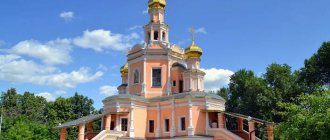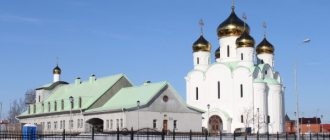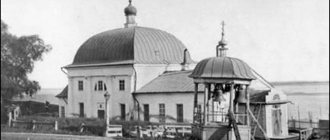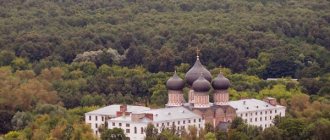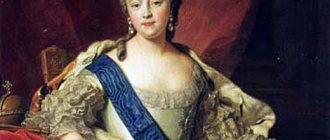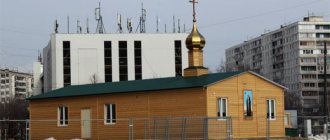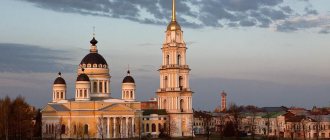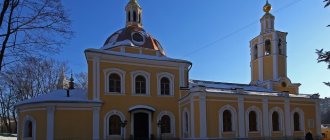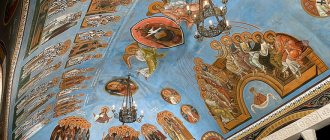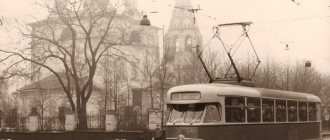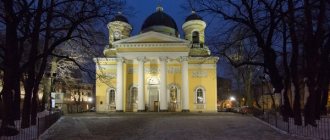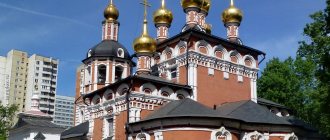Boris and Gleb Church in Degunino is one of the oldest in Russia. The shrine is named in honor of the great martyrs - passion-bearers, sons of Prince Vladimir - Boris and Gleb. According to the first mentions of the temple, its centuries-old history dates back to 1585, when it was destroyed by an enemy army.
Since then, the temple has been repeatedly restored, destroyed, closed, and even given to the use of several non-religious organizations. However, today the church has been completely restored, welcomes parishioners and serves as “God’s house” for all believers.
How to get there?
You can get to the church by different types of transport, including using a personal car.
| By car | Driving directions are different and depend on the driver’s address. Therefore, the easiest way is to enter the coordinates of the temple in the navigator: 55°52'00.4″N 37°32'03.0″E, which will pave the most convenient and shortest path. |
| Metro | You need to get off at the Petrovsko-Razumovskaya metro station. Take any of the proposed buses: No. 191, 194 or 672. Go to the stop “Institute of Eye Microsurgery”. From the stop, walk to Deguninskaya Street, and it will take you less than 10 minutes to walk along it to the temple. |
| By train | Direct trains depart from Leningradsky Station. You should get off at the Mosselmash platform, walk a few minutes to Puteyskaya Street and then to Deguninskaya. |
Story
The Church of Boris and Gleb in Degunino is called a “prayerful”, holy place with special energy. This is connected with his history. No force could destroy the church forever. It was restored practically from the ashes, and today it operates successfully, receiving visitors.
Saints Boris and Gleb in whose honor the temple in Degunino is named
The temple was named in honor of the first saints Boris and Gleb. The sons of Prince Vladimir of Kyiv were treacherously killed by their elder brother Svyatopolk after the death of their father. The murder of the two brothers was committed due to Svyatopolk’s reluctance to share power with them.
After their death, Boris and Gleb were canonized as martyrs and passion-bearers. They are also considered the “heavenly protectors” of Russian princes and patrons of Rus'. Over the years, various cultural monuments have been created in their honor.
The temple has a long history, dating back several centuries:
- 1585 – the temple was mentioned for the first time. This was the time when it was burned by the Polish-Livonian army. It was built from wood, since there was simply no money for more durable building materials. The enemy did not need much time and effort to destroy the shrine. The destruction of the church entailed the transition of Degunino from the status of a village to the status of a village.
- 1633 - a new temple was erected, also named in honor of the princes. Additionally, a chapel was built in memory of St. John the Theologian.
- 1700 - by order of Peter I, the village and the church were given to the Moscow Alekseevsky nunnery.
- 1762 - a new single-altar church made of wood with a stone basement was erected. They named it in honor of Boris and Gleb.
- 1764 - Catherine II transferred Degunino and the Boris and Gleb Church to the state. The peasant people became “economic”, and the church became an ordinary parish.
- 1863 - thanks to the construction of the railway (1843-1851), the life of the residents of Degunino and the church improved significantly. The peasants received a decent monetary reward for the alienation of land for construction. Funds appeared for the construction of a stone temple. This was necessary, first of all, to expand the territory of the church, since the parishioners were not only from Degunino, but also from nearby villages and hamlets.
The rural community turned to Metropolitan Philaret for permission to fulfill a long-standing dream and received consent in response. Construction of the three-altar stone church was completed by 1866.
A significant contribution to its creation was made by V. A. Prorekhov, the owner of a brick manufacturing plant. He provided 360 thousand bricks. The new building was erected next to the old temple, which stood until 1884. The author of the stone structure project was a Russian architect, Vladislav Osipovich Grudzin.
- 1866 - the church was consecrated in memory of princes Boris and Gleb.
- 1925 – the Charter of the church community was approved and members of the Orthodox community in Degunino were designated.
- After the revolutionary events, the temple was opened until 1930. In the early 30s. services were suspended. And only 11 years later the church was officially closed.
- 1941 - official closure. From that time on, the church housed an outpatient clinic. After it, the production workshop of the Rodina factory was located. During this time, some of the temple structures were destroyed and changed.
- 1960 – the church was considered one of the architectural monuments protected by the state. The same year was significant with the annexation of Degunino to Moscow.
- From 1987 to 1991 – used as a parking lot.
- 1991 - the temple was handed over to the Orthodox community. From this moment the restoration of the Boris and Gleb Church begins.
Over the course of several years, the general appearance of the building, the bell tower, is being restored, the interior decoration, paintings, roofing are being updated, and the iconostasis is being restored. The abandoned church was brought back to life and work through the common efforts of believers. Now it is an important monument of cultural heritage, God's home for many Orthodox Christians.
Saints Boris and Gleb
Many churches, monasteries, icons, and frescoes are dedicated to Boris and Gleb. The sons of Prince Vladimir were the first saints in Rus' to be canonized simultaneously by the Russian and Constantinople churches. After death, the brothers are considered patrons of the Russian land and princes, as well as healers from God.
Boris and Gleb were raised in Christian piety, the purpose of their life was to serve God and obey God's laws. The princes were distinguished by their kindness, mercy, compassion, and love for everything around them. They avoided pride, but followed humility, sacrificing themselves for the sake of others.
When the brothers' father died, the eldest son Svyatopolk immediately declared himself the Grand Duke of Kyiv. Thinking that Boris and Gleb could lay claim to his power and lands, he decided to deal with them. Svyatopolk's treachery shocked even his subordinates; nevertheless, the brothers were killed on his orders.
Despite the fact that both Boris and Gleb knew about Svyatopolk’s plans, the brothers did not resist him. They accepted this decision and did not allow themselves to resist the wishes of their older brother. The holy princes sacrificed their lives for the sake of such an important Christian virtue as love. They showed by their own example that one cannot respond to evil in kind, even if it comes at the cost of life.
The death of Boris and Gleb for the sake of preventing internecine conflicts became a fertile seed that strengthened the unity of the Russian people.
Wooden again
And in 1762, the very old dilapidated church was rebuilt. However, the new temple is being built again from wood. Two years later, Degunino, which stands on the Likhoborka River, was removed from church ownership and transferred to civil jurisdiction, that is, secularized. From 1843 to 1851, construction of a railway was carried out in Russia, connecting Moscow with St. Petersburg. The line passed through lands belonging to the village, for which the community was paid a fairly large amount of compensation for the alienated lands. This prompted the Degunin people to think about a new stone temple. An appeal from parishioners and the rector of the church, priest Simeon Florovich Strakhov, to Metropolitan Philaret, Vladyka of Moscow, was sent in 1863. In the neighboring village of Verkhniye Likhobory there was a stone factory, and its owner, the merchant of the 1st guild Prorekhov V.A., provided the necessary amount of bricks in the amount of 360,000 pieces for future construction. That was the biggest contribution to this good cause.
Briefly about Degunino
The first mention of the village dates back to 1328. Then Ivan Kalita granted it to the family of Princess Ulyana. After 17 years, Degunino was transferred by Simeon the Proud to his wife Maria. Later it was in the power of Prince Andrei, and only then was it handed over to the Orthodox Church, which ruled the village for 4 centuries.
This is due to the fact that the wife of the deceased Dmitry Donskoy built the Cathedral of the Nativity of the Virgin Mary in honor of her husband, for the maintenance of which his son Andrei gave Degunino along with all the land. Then the village is mentioned 2 centuries later, and is listed as the property of the Church of the Nativity.
During the Time of Troubles (1598 - 1613), Degunino and the church were destroyed. It moved from the status of a village to the status of a village. Restoration was possible only in 1633, but poverty continued to reign in the village. The church was exempted from paying tribute by Patriarch Joasaph for 40 years, which helped Degunino improve his financial situation.
In 1700, the village was given to the Moscow Alekseevsky nunnery, and in 1764 it again became state-owned, and the peasants became economic. In 1863, a railway was built through Degunino, which also contributed to an increase in the standard of living of Degunino residents.
Photo of the village of Degunino
Since the end of the 19th century, Degunino was considered a fairly prosperous settlement. Local residents mainly received income from gardening and the sale of dairy products. In 1960, the village ceased to exist independently, as it became part of Moscow. Some streets and even districts were named in memory of him.
"Prayer" church
The Temple of Boris and Gleb in Degunino is first mentioned as being destroyed by Polish-Livonian troops. This happened in 1585. The village itself was mentioned for the first time in 1336 in a charter from Ivan Kalita. It is impossible to admit the idea that there was no church in the village, especially since in 1394 the settlement became part of the church for 400 years. The village near Moscow, known as Deguninskoe when it was founded, ceased to exist in 1960. It became part of Moscow, which is constantly expanding its borders. The Temple of Boris and Gleb in Degunino is known for being destroyed repeatedly by fire. But every time, on the site of a destroyed temple, a religious structure made of wood is re-erected. This happened, perhaps, due to a lack of funds for the construction of a stone building. For example, in 1633 the church was built with the money of a local priest.
Architectural features of the temple
The Temple of Boris and Gleb in Degunino is made in an eclectic style with elements of Russian architecture. The building belongs to the basilica type.
Distinctive architectural features:
- On both sides of the temple there are religious paintings in place of some of the windows. They convey the inner atmosphere of this shrine, absorbing parishioners into a world of spiritual beauty and tranquility.
- The black crown gives its appearance originality and expressiveness.
- Large arched windows allow sunlight into the building well.
- Above the entrance doors are depicted the faces of saints.
- There are 3 altars in the church: the main one - princes Boris and Gleb, 2 additional ones - St. Nicholas and the icon of the Mother of God “Joy of All Who Sorrow”.
- Attached to the main part of the church is a rounded apse (eastern side) and a bell tower consisting of 2 tiers (western side).
- Large triple columns dissect the façade of the building. They are complemented by wide archivolts and loose entablatures.
Boris and Gleb Church has undergone partial architectural changes more than once, without losing its original style.
New life of the Boris and Gleb Church
The temple began to come to life after the new registration of the community and the transfer of the church building to it in 1990. The first divine liturgy was celebrated in the church in 1991 on July 14. And the gradual restoration of the Borisoglebsky religious building began. From 1994 to 2005, the walls were painted twice, the bell tower tents and church buildings were restored, the roof and appearance were updated, and the iconostasis was restored. This temple can also be called a passion-bearer, like those saints in whose honor it was originally erected, the Good Boris and Gleb. This Orthodox Church is located at the address: st. Deguninskaya, 18a.
Interior decoration
The Church of Boris and Gleb has been actively restored since 1991 by the joint efforts of many believers. In Degunino, special attention was paid to this church; it was practically the only important cultural property of the village.
Local residents regularly came to the temple for spiritual help, prayed, purified themselves, and found peace and tranquility in this shrine. Therefore, during its reconstruction, all funds were aimed at strengthening and updating the structure.
The temple has a gilded iconostasis with beautiful carvings. It is filled with valuable icons, many of which were painted anew. The icons of the Vladimir Mother of God and the Grand Dukes Boris and Gleb are the most revered.
A whole cycle of oil paintings is depicted on the walls. The wall paintings and frescoes were restored as much as possible. The building is very spacious; the painted cross and domed vault visually enlarges the space.
Large arched windows perfectly transmit sunlight, additionally creating a warm and bright atmosphere. Beautiful church utensils attract the eye. As in any Orthodox church, the temple has many wall crosses and images of Jesus Christ at different ages.
A lot of human labor and a lot of money were invested in the restoration and improvement of the temple. Thanks to this, the Boris and Gleb Church in Degunino is today considered one of the most luxurious rural churches.
Patronal holidays
In the Boris and Gleb Church, patronal feasts are celebrated several times a year, since it is a three-altar shrine. For each such event, the temple is decorated with flowers, dressed in festive vestments, and the most beautiful utensils are prepared. The choir creates a solemn, festive atmosphere.
Both regular clergy and parishioners are preparing for patronal feasts. Even before the holiday, everyone gathers in the church and honors the memory of the saints. Usually, after the cathedral prayer, a procession of the cross is held.
Schedule of patronal holidays:
| May 15 | Transfer of the relics of Boris and Gleb |
| August 6 | Boris' death day |
| September 18 | Day of Gleb's death |
| November 6 | Memorial Day of the Icon of the Mother of God “Joy of All Who Sorrow” |
| December 19th | Memorial Day of St. Nicholas the Wonderworker |
| 22nd of May | Transfer of the relics of St. Nicholas the Wonderworker |
Prince Svyatopolk, who killed his brothers, was expelled from the country
When the brothers grew up, the prince gave Rostov to Boris, and Murom to Gleb. Just before his death, Vladimir summoned Boris, gave him an army and sent him on a campaign against the Pechenegs. Soon the prince died, and his eldest son Svyatopolk declared himself Grand Duke of Kyiv.
He sent assassins to his brothers to rule Russia single-handedly. The brothers accepted death meekly. Boris dismissed his army, saying:
“I won’t raise my hand against my older brother, that’s not Christian.”
Boris's body was taken to Vyshgorod and hidden in the Church of St. Basil the Great.
Gleb also knew about the impending death that overtook him near Smolensk. Having abandoned civil strife, Gleb humbly accepted death following Boris. Yaroslav the Wise, Prince of Kiev found the remains of St. Gleb and placed them next to the relics of Boris in the Church of St. Basil.
Svyatopolk, for his atrocities, was nicknamed the accursed by the people and spent the rest of his life in exile.
Temple shrines
The Temple of Boris and Gleb in Degunino has its own revered shrines. This is an ark with the relics of the Optina elders and an ark with the relics of saints: Philaret of Moscow, Innocent of Moscow and Irkutsk, Thaddeus and Arseny of Tver, Bethlehem babies, Macarius of Zheltovodsk and Kalyazin, fathers beaten in Raifa, Anna Kashinskaya, Catherine, Alexander Svirsky.
Parishioners of the temple claim that these relics help them in the fight against illnesses and in solving problems of various kinds.
The first Russian saints
Why are they martyrs and passion-bearers? Because they were treacherously killed by their own brother Svyatopolk, nicknamed by the people because of this “The Accursed”. The brothers accepted death voluntarily, knowing about it in advance. Boris and Gleb did not raise their hands against their older brother. An integral part of the Christian faith - non-resistance to evil through violence - was a novelty for pagan Rus', which had just adopted Orthodoxy. The fratricide Svyatopolk fled to Poland from the troops of Yaroslav the Wise, but, like Cain, he could not find a place for himself anywhere. According to legend, even his grave emanated a stench. And after canonization, Boris and Gleb became the patrons and guardians of Rus'. They began to be honored immediately after death.
Daily life of the temple
The daily life of the Boris and Gleb Church is quite rich and varied. Full-time clergy and parish organizations conduct daily divine services, engage in spiritual education, help needy children and adults, perform various sacraments, care for orphans and sick people, and organize trips to shrines.
The Temple of Boris and Gleb helps:
- Children's boarding school No. 28, where disabled children are brought up.
- Psychoneurological boarding school for adults No. 25.
- Moscow children's psychoneurological hospital.
- Research Institute of Pediatric Surgery and Pediatrics in Moscow.
- Bureau of Medical and Social Expertise.
- Hospice No. 2.
At the temple there are:
- Children's and adult Sunday school. Spiritual and general education disciplines are studied. Particular attention is paid to sports and physical education. Visits to museums, exhibitions, holy places and other cultural and historical monuments are organized. Thematic games and competitions are held. They learn icon painting, singing, and languages. You can register for Sunday school by visiting its director in person.
- Library. The temple website contains a library in which you can find various sermons, reports, articles, addresses and other publications by clergy.
- Sisterhood. She is engaged in the spiritual education of children and adults, organizes trips to holy places, cares for sick children, and promotes their treatment. The sisterhood also organizes parties for children, gives gifts, brings them to services, and is involved in their development.
- Youth movement. Conducts conversations with the priest, asks questions on spiritual topics, arranges trips for pilgrims, takes part in games and competitions, and provides assistance to needy and sick people.
Boris and Gleb Church also holds sacraments:
- repentance;
- communion;
- baptism;
- anointing;
- marriage;
- Unction.
All activities are carried out with donations from church parishioners.
Opening hours and schedule of services
The temple receives visitors every day. On weekdays, opening hours are from 8:00 to 19:00, on weekends – from 7:00 to 19:00.
Schedule of services:
Monday Friday:
- 8:00 – confession;
- 9:00 – Liturgy.
Saturday:
- 8:00 – confession;
- 9:00 – liturgy;
- 17:00 – all-night vigil.
Sunday:
- 7:00 – liturgy;
- 8:00 – liturgy;
- 16:00 – Vespers and Akathist depending on the holiday.
During major church holidays, the liturgy is held according to the Sunday schedule. All-night vigil the day before - at 17:00.
In the Church of Boris and Gleb, visitors must follow some rules:
- Do not come to the temple premises under the influence of alcohol or drugs.
- Do not make noise, do not talk loudly, do not use obscene language.
- Women can visit the temple only with their heads covered and in a long skirt or dress.
- Men are not allowed to visit the temple in beachwear, sportswear, or shorts.
- Visitors must be baptized and wear a cross.
Reception of believers outside of work hours is impossible. In some cases, this is discussed in advance with the clergyman.
Interesting facts about the Church of Boris and Gleb in Degunino
Boris and Gleb Church in Degunino is famous not only for its centuries-old history, but also for some interesting facts:
- During Napoleon's large-scale attack on Moscow in 1812, the Church of Boris and Gleb survived.
- Despite the atheism promoted by the authorities in 1920-1930, services in the temple continued to be held until the early 30s, and even the Charter of the believers of the Borisoglebsk community was created. Then the services stopped due to the fact that there were no clergy in the temple.
- Residents of the village of Degunino revered their temple so much that all the proceeds from the alienation of land for the construction of the railway were invested in the construction of a strong, stone church.
- The temple was built in the shape of a parallelepiped, which has one common internal space.
- In 2005, a fire occurred on the territory of the Boris and Gleb Church, as a result of which the carpentry workshop and the building attached to it burned down. However, the artos that was prepared for consecration and the paper icons remained intact and unharmed.
It is not for nothing that believers call the Church of Boris and Gleb a “praying” place. It was repeatedly revived after destruction, people gave their last funds and strength for its restoration. In Degunino, the temple is considered not only a landmark, a cultural and historical monument, but also the most revered shrine, to which Orthodox Christians go as to God’s house.
Article design: Vladimir the Great
History of the temple
The temple was first mentioned in 1585 as destroyed by the army of an enemy country. The very area in which it was located was mentioned for the first time in 1336. It was the village of Degunskoye near Moscow. After some time, it became part of the city of Moscow.
It should be noted that the Church of Saints Boris and Gleb in Degunino itself became famous among Orthodox parishioners due to its frequent destruction. But despite this, every time after the church was destroyed, it was reborn again. It was rebuilt from wood; this was possibly due to a lack of funds for the necessary, stronger building materials.
Dear brothers and sisters! We invite you to visit the unique resource https://www.slovo-pomoshi.ru/. With its help, you can convey your aspirations to St. Petersburg churches, chapels, monasteries, and also contact the righteous at the place of their burial. We will write a note ourselves, take it to the temple and send you a photo report by email. Turning to God with the help of prayers has helped many people overcome grief, regain health and the joy of worldly life.
Useful articles:
ABOUT THE POWER OF PSALMES 26 and 90. “Well, so I’ll tell you what! You once told me that the enemy was shooting his arrows at you. Do not be afraid! None of them will touch you, don’t be afraid of any rubbish: rubbish will remain rubbish. Just take my advice as a rule, listen: read morning and evening before your prayer... Read more
Pray to Saint Nicholas the Wonderworker and Saint Spyridon of Trimifunt. After all, they are our first aiders and prayer books. Pray to Saint Nicholas the Wonderworker and Saint Spyridon of Trimifunt. After all, they are our first aiders and prayer books. They are given special grace to help those in trouble, even in hopeless situations. They will help you too. Of course, on your part, you do what you need to do. ... Read more
“MOTHER’S ORDER BEFORE DEATH” (be sure to read this note) “Pray for me, child, when I am no longer with you, Don’t drink wine for me, pray in your own words. Take to the poor all that you collected for the luxurious funeral, And I don’t need dead wreaths, you give me a wooden cross. In the bright Temple, my beloved, where the prayer is... Read more
REVEREND STILIAN - PATRON AND HEALER OF CHILDREN Have you ever seen such an interesting icon, which depicts a holy monk holding a baby in his arms? Yes, this icon is very rare, and few people know such a saint... but this is here, in Russia. And in Greece and Orthodox Cyprus everyone knows this saint and reveres him very much!!! P… Read more
For example, back in 1633, the revival of the church took place with the money of a local priest. Since 1676, the temple, according to all documents, is listed as the Church of Saints Boris and Gleb with the chapel of John the Theologian. In 1700 it was transferred to the Alekseevsky Monastery. During the invasion of Napoleonic troops, when many churches were burned, this temple survived and did not burn down.
It became stone in 1884. It was built in the Russian-Byzantine architectural style. The construction turned out to be very beautiful in the form of a parallelepiped, which has one internal space. The iconostasis looks quite rich, its walls and vaults are painted extraordinarily beautifully.
